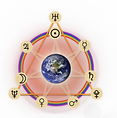Mermaids in the Basement
- By Nancy de la Vierra
- Feb 26, 2018
- 4 min read
I started early, took my dog,
And visited the sea;
The mermaids in the basement
Came out to look at me.…
--Emily Dickinson
I inherited from my father a compelling love of the sea and those creatures who inhabit it. Dolphins, in particular, have mystified and inspired humanity throughout the ages. Only the most callous individuals would not be moved by their playful antics. They remind us of our better selves. I was about four when I caught my first glimpse of them in my father's National Geographic. Their perpetual smiles beckoned me, their apparent love of life and felicity warmed my heart. Many early civilizations thought of dolphins as our cousins of the sea. In astrological analysis, Cancer is the first water sign of the zodiac, ruled by the Moon and has a strong kinship with sea creatures and ocean life.
Since March of this year, over 120 bottlenose dolphin carcasses have been found in a network of bays along the Texas Gulf Coast. Their deaths are man-wrought; it's just a matter of determining what toxic poisons or combinations dealt the blow. Marine biologist Nina Young commenting on the recent deaths said: "Dolphins live along our coasts, using the same water we do and consuming the same fish we eat. If indeed they are dying because of the consumption of contaminated fish, then these contaminants could wind up on our plates."
On our plates indeed. A 1991 Consumer Report found that 43 percent of the salmon and 25 percent of the swordfish in the supermarket shelves contained PCBs as well as mercury, lead and arsenic. We are systematically and unfortunately, quite legally, killing our oceans. Most marine pollution is attributable to fertilizers, pesticides and the discharge of sewage sludge into the sea. A 9.5 mile sewage effluent pipe, underway in Providence, Mass., will pump more than a billion gallons of waste a day into Cape Cod Bay. This project has earned the euphemistic title of "The Big Flush."
PCBs (polychlorinated biphenyls) suppress the immune system. In 1987-88, over 2,500 bottlenose dolphins died of bacterial infections along the East Coast. Tragically, in 1988-89, half the population of European harbor seals died of a virus resembling distemper. Sea turtles around the world have developed tumors on their necks and flippers that develop until swimming or eating is no longer possible. The oceans are vast and seemingly eternal but so are the seas of man-made pollutants that threaten to destroy them. In the North Sea, where harbor porpoises are disappearing, recorded levels of PCBs in their flesh have been alarmingly high.
I think it is noteworthy that our cetacean cousins choose to beach themselves on our doorsteps when faced with unspeakable adversities. We are, after all, the architects of their undoing. Perhaps on a psychic level, they are reaching out to their executioners, asking for mercy and, more importantly, extending a warning. In 1854, Chief Seattle, addressing white civilization, issued a timely admonition:
What is man without the beasts? If all the beasts were gone, men would die from a great loneliness of the spirit. For whatever happens to the beasts soon happens to man.
Species of plants and animals are exiting our planet at breathtaking speed. It is a situation so dire that it is an onerous task to speak of it with any kind of patience. As one after another makes their way down that long, gray road to extinction, it is easy to despair. But we must not. Ralph Waldo Emerson once said: "… if the single man plant himself indomitably on his instincts, and there abide, the huge world will come round to him.…" A case in point. Most well informed people are aware of the murderous toll drift-netting takes on seals and especially dolphins who tend to swim with the intended victims—tuna. A small group of individuals, mostly adolescents, deluged the top executives of Heinz-Starkist at their residences with mail expressing their anger. They were relentless, indomitable. Eventually Starkist buckled to public sentiment and acknowledged by halting drift netting!
Consider the gentle beluga whale, the only freshwater whale in existence. Its fat is already sealed. The species has the misfortune to inhabit the St. Lawrence River in Canada. Over the last 40 years, the buildup of industrial pollutants and human waste has rendered the beautiful whale TOXIC. The concentrations of dangerous chemicals are so high that, under Canadian law, their bodies must be disposed of as toxic waste. And consider the plight of yet another decidedly benign creature, the manatee—their doom brought about by the proliferation of high-speed boats and a general destruction of habitat. The thrill of speed is apparently more important than the continuation of a species whose North American ancestors evolved in the Pleistocene Epoch a million years ago.
As more species are irretrievably lost, our own futures will be questionable. And as a corollary, with magnificent examples of creation gone, would you want to share the world with the sorry assortment of cockroaches, slugs and weevils that remain? The recompense is not in the roster of wild things seen, but in the sentiments engendered by their presence. I can't help but think that the absence of dolphin dreams would be felt throughout the universe. The dearth of diversity certainly would leave one with a great loneliness of the spirit.

© 1992 and 2018 by Nancy de la Vierra. All rights reserved.







Comments